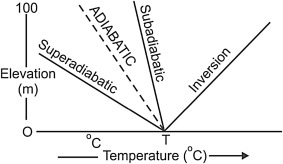LAPSE RATE AND ADIABATIC LAPSE RATE
Overview
When we discuss the temperature structure of the atmosphere, both “temperature gradient” and “lapse rate” terms are used.
Temperature decreases as altitude increases. The decrease in temperature in the air at higher altitudes is known as vertical temperature gradient. The reasons for decline in temperature with increased altitudes are:
- The air is heated by the earth,
- Reduction in water vapor content which reduce the capacity to hold heat and,
- Expansion of air at higher elevation.
Lapse Rate
- It is the rate of temperature decrease with increase in height in the atmosphere. The vertical temperature decrease is expressed as lapse rate.
- The normal lapse rate is about 50C/km. It means, the temperature is decreased 6.50C per kilometre with increased altitudes.
- Ambient or prevailing lapse rate: The actual atmospheric temperature change with altitude; not only does water content modify lapse rates, but wind, sunlight on the Earth’s surface, and geographical features change actual lapse rates.
Adiabatic Lapse Rate
- Change of temperature with a change in altitude of an air parcel without gaining or losing any heat to the environment surrounding the parcel is called adiabatic lapse rate.
- It is the rate at which the temperature changes as air rises or falls.
- If we assume a bubble of air rising through a dry atmosphere with no mixing or heat exchange between the bubble and its environment, the bubble will expand and cool. The cooling is said to be at the dry adiabatic lapse rate (DALR). Hence, DALR is negative of the temperature gradient that is established as dry air expands adiabatically while ascending.
- It is constant for dry air and dry adiabatic lapse rate is 10.00C/km.
- Dry Adiabatic Lapse Rate: Assumes a dry parcel of air. Air cools 3°C/100 m rises in altitude.
- Wet adiabatic lapse rate:As parcel rises, H2O condenses and gives off heat, and warms air around it. Parcel cools more slowly as it rises in altitude, ≈6°C/1000 m.
- A comparison of dry or wet adiabatic lapse rates to prevailing lapse rates gives a sense of the stability and mixing conditions of the atmosphere.

(source- sciencedirect.com) - Superadiabatic: Ambient lapse rate > adiabatic indicates unstable atmosphere. Vertical motion and mixing processes are enhanced. Dispersion of pollution plume is enhanced.
- Subadiabatic: Ambient lapse rate < adiabatic. It indicates stable atmosphere, vertical motion, and mixing are suppressed. Dispersion is suppressed, and contamination is trapped.
What is Inversion?
- The condition of abrupt rise in temperature instead of fall is called inversion.
- It is an extreme case of subadiabatic, where temperature actually increases with altitude near the ground before it begins to decrease with altitude.
- This results in warm, low-density air riding on top of cool high-density air; a very stable air column that traps pollution near the ground.
See also…
WEATHER ELEMENTS- AN OVERVIEW